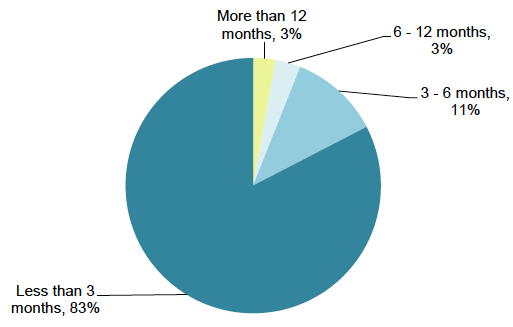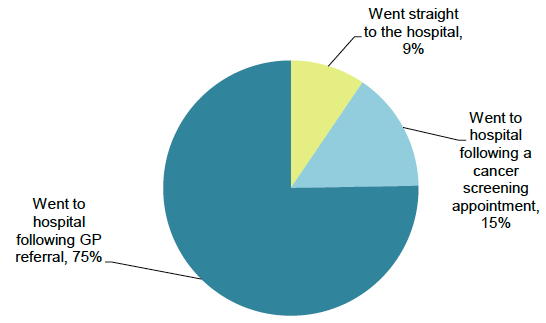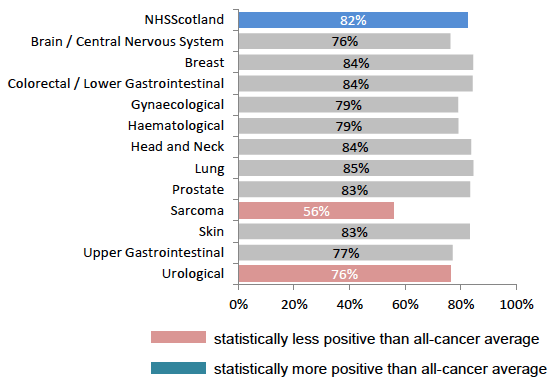Scottish Cancer Patient Experience Survey 2015/16
Results from the 2015/16 Scottish Cancer Patient Experience Survey. The survey covers the full care journey that a cancer patient experiences, from thinking that something might be wrong with them to the support they received after their acute-care treatm
This document is part of a collection
Seeing the GP
The first questions in the survey seek to understand patients' experiences leading up to their first hospital visit for their cancer, which marks a key milestone in their cancer care.
Early diagnosis is a critical issue in Scotland, and is widely recognised as significant in improving people's chances of surviving cancer.
The impact of screening initiatives among certain cancers are reflected in the results, with breast cancer patients being the most likely to go to hospital following a screening appointment; conversely, those patients with brain/central nervous system and lung cancer - which can be more difficult to diagnose - are more likely to have gone directly to hospital without seeing their GP.
Responses from patients who were diagnosed at non- NHS Scotland facilities have been excluded.
Wait before seeing a GP or other doctor for the first time
Once patients first felt that something might be wrong, most cancer patients (83%) reported waiting less than three months before going to see their GP or another doctor about the problem. Six per cent of patients waited at least six months before seeing a doctor (Figure 1).
Figure 1: How long patient waited once first thinking something might be wrong before seeing a doctor

Amongst different tumour groups, those with breast tumours were the most likely to see a doctor within 3 months (89%). This was the only tumour group with a score statistically above the all-cancer average. Head and neck (76%), and prostate (77%) tumours were statistically below the all-cancer average.
Route to first hospital visit
Patients referred to hospital by GP
The majority of patients (75%) were referred on to hospital for their cancer by their GP (Figure 2).
Figure 2: Patient's route to first hospital visit

Of these patients, the majority (78%) reported seeing their GP only once or twice before being told that they needed to go to hospital. However, around one in five saw their GP 3 or more times before being referred to hospital (Table 2).
Table 2: Number of visits to GP before hospital
| Before you were told you needed to go to hospital about cancer, how many times did you see your GP about the health problem caused by cancer? |
n |
% |
|---|---|---|
| I saw my GP once |
1,921 |
57% |
| I saw my GP twice |
708 |
21% |
| I saw my GP 3 or 4 times |
463 |
14% |
| I saw my GP 5 or more times |
293 |
9% |
| Total |
3,385 |
100% |
Patients from certain tumour groups tended to take longer to reach hospital once they had approached their GP. Patients in colorectal / lower gastrointestinal (71%), haematological (66%), lung (70%) and upper gastrointestinal (70%) tumour groups were all statistically less likely to be referred to hospital within two GP visits than the all-cancer average.
In contrast, patients with breast tumours (95%) and skin tumours (85%) were statistically above average. This may reflect relative difficulties in identifying some types of cancer.
Going to hospital following a screening appointment
Fifteen per cent of patients attended hospital following a screening appointment. The highest rates for this were observed amongst patients with breast (33%) and colorectal (23%) tumours.
Going to hospital directly
Nine per cent of patients went directly to hospital. This was most common amongst patients with brain / central nervous system tumours (37%).
Patients' feelings regarding their wait before seeing hospital doctor
The majority of patients (82%) felt that they were seen by a hospital doctor as soon as they thought it was necessary (Table 3).
Table 3: Length of time before first appointment with hospital doctor
| How do you feel about the length of time you had to wait before your first appointment with a hospital doctor? |
n |
% |
|---|---|---|
| I was seen as soon as I thought was necessary |
3,856 |
82% |
| I should have been seen a bit sooner |
549 |
12% |
| I should have been seen a lot sooner |
280 |
6% |
| Total |
4,685 |
100% |
Patients from different tumour groups felt differently about the length of wait to see a hospital doctor. Results for patients with sarcoma and urological tumours were statistically below the all-cancer average (Figure 3).
Figure 3: % seen by hospital doctor as soon as they thought necessary, by tumour group

Differences in patients' views about the wait before seeing a hospital doctor can partly be explained by the route that they took to hospital. Those that went to hospital following a screening appointment were most likely to be positive (95%) and unsurprisingly those who attended hospital after five or more visits to their GP practice were least likely to be positive (46%) (Table 4).
Table 4: % seen by hospital doctor as soon as they thought was necessary, by route to hospital
| Route to first hospital appointment |
% seen 'as soon as necessary' |
|---|---|
| Patient went to hospital following a cancer screening appointment |
95% |
| Patient went straight to the hospital |
89% |
| Patient saw GP once |
86% |
| Patient saw GP twice |
80% |
| Patient saw GP three or four times |
64% |
| Patient saw GP 5 or more times |
46% |
Contact
There is a problem
Thanks for your feedback